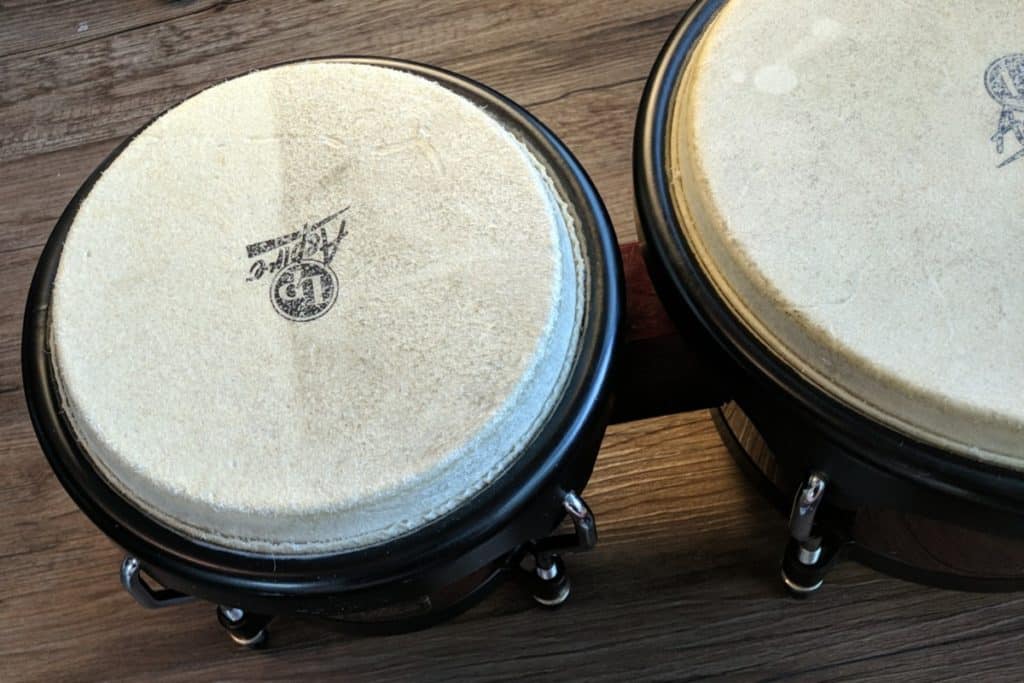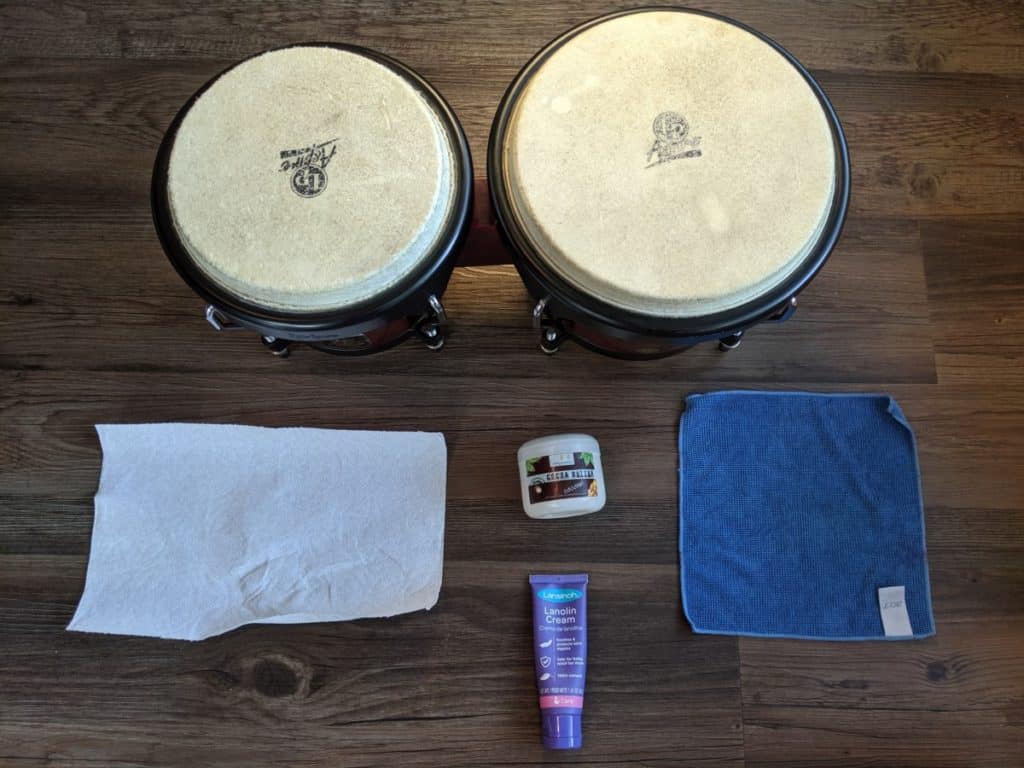This post contains affiliate links. We earn commissions if you purchase products from retailers after clicking on a link from our site. As an Amazon Associate, we earn from qualifying purchases.
Maybe you’ve pulled out your bongo drums and noticed that there is a lot of grime on the edges or wherever you hit the drum. It is a little gross to think of all the dirt that has been on your hands transferring to the bongo drum head over time… but what is the best way to clean your bongo drum heads without damaging them?

By the way, looking for recording equipment and musical instruments? Check out Sweetwater.com for microphones, monitors, audio interface or any other recording gear that you could ever need. (Affiliate Link)
Cleaning your bongo drumheads can be done with either a little water, a scent-free lotion, or a skin-safe oil in combination with a soft rag. Never use any cleaners containing bleach or ammonia or any solvents–a good rule of thumb being to only use that which you would use on your own skin without drying it out.
How much water is too much water? How much oil or lotion is too much or too little? What about hand sanitizer or even soap and water? There’s a lot of questions as to what chemicals are okay and not okay for bongo drums. Let’s dive into the question and see what we can learn.
I actually documented the process in a video if you’re curious to see if water wins against cocoa butter or lotion
How to Clean Bongo Drums: 4 Methods
I recently tested methods 1 and 2 on my bongo drumheads, the other day and I learned that my drumheads were dirtier than I thought. The picture above is an example of how much dirt had accumulated, even though in my opinion my bongos are relatively clean.

Method 1: A Damp Rag
The easiest method that I’ve tried is to simply use a slightly damp rag and to gently scrub the drumhead.
I just went through this process on one of my bongo drums, and I found it to be very effective in removing the dirt that had collected there for years.
The biggest disadvantage to using any kind of water on your bongo drums is that the water will loosen and tighten the drumheads as the drumheads are moistened and dried.
During this process I learned a few invaluable tips:
- Make sure to detune your bongos a couple quarter turns on each lug nut before starting until the bongo drumheads completely dry out.
- Make sure your rag is only slightly damp. The drumhead will loosen and then constrict as the water is applied and as it evaporates.
- Ensure you have enough water so that you are not scraping away your drumhead skin.
- Avoid scrubbing on the bearing edge as this is where the skin is most sensitive to damage. In the case of my bongo drums, the skin would flake off past the bearing edge when I used a damp rag to scrub.
- A paper towel will work fine in a pinch, but the paper towel will start to disintegrate pretty quickly.
Method 2: Lotion or Skin-Safe Oil
Another method to clean your bongo drumheads is to use an unscented lotion or a skin-safe oil.
The idea behind a hand lotion or an oil is to apply enough to cover the drumhead and allow the oil or lotion to sit for several hours. Once the dirt and grease has had a chance to be infiltrated by the new oil or lotion, you then use a clean rag to pick up the oil and anything else that comes with it.
I tried to use two types of oils, lanolin, and cocoa butter on my hembra bongo drumhead and I found it to be not as effective in picking up dirt as plain water and a rag.
However, although oil or lotion may not pick up dirt as effectively, it is going to be easier on the drumhead, since oil doesn’t evaporate.
The biggest downside to oil is that it can change the sound of your drum, and perhaps not in the way you are hoping for.
Some tips to applying oil or lotion on your drum:
- Less is more: Start small, since removing oil or lotion is more tricky than adding it.
- Rub the oil or lotion on your hands before applying to the drumhead: This will ensure you don’t have a spot on the drum that’s saturated with oil.
Method 3: Sanitizing Bongo Drums
Some libraries actually check out bongo drums and other instruments. If you’re lucky, they will try and sanitize the instrument as best as they can when they lend them to someone new.
If you know that’s not the case, you can take matters into your own hands (ba-dum psh).
Furthermore, if you are using bongo drums from your school, you can count on that those drums are never cleaned. If that worries you, you can do a quick sanitization.
Many hand sanitizers contain alcohol, which is used in hospitals all over the world for sanitizing. Using a hand sanitizer with alcohol on your hands, and rubbing your hands until they are mostly dry, and then rubbing the bongo drumheads with your hands will be sufficient for killing the germs on the drumheads without saturating the skin with alcohol which can damage the drumhead.
Do not apply the hand sanitizer directly to the drumhead as alcohol evaporates quickly, encouraging water to evaporate as well. Rapid evaporation can actually damage your drumhead.
Method 4: Removing Fur and Stubble
Although it’s easy to forget, the animal skin of a bongo or conga drumhead do indeed come from animals–and sometimes the processing of the skins does not remove all the fur. In this case, if used carefully, a straight edge razor can be used to scrape off any fur or stubble.
Here is an example I found on YouTube of someone in this situation:
Make sure to not let the blade face the drumhead diagonally and puncture the skin.
What’s Okay to Use for Cleaning Your Bongo Drums?
Our skin is an amazing organ that can tolerate a lot of exposure to many different chemicals. Our skin is alive, though, and is constantly being replenished with oils and moisture which are necessary to maintain suppleness and strength.
Animal skin drumheads such as on Bongo drums do not automatically heal like our skin does, therefore it’s important to only use chemicals that do not harm or change the drum’s consistency.
Here are some materials that are okay for cleaning a bongo drumhead:
- Water: This comes with a big warning: Water can be fatal for a bongo skins. Even rapid changes in humidity can cause a bongo drumhead to pop, so be very careful to only use a tiny amount of water for cleaning your drumhead
- Lanolin: Lanolin can be sold in its purest form as a lotion for breastfeeding mothers. There are other lotions with lanolin–try to find one that has no scent.
- Manteca de Corojo, AKA Palm Oil: This is a favorite among conga and bongo players as a conditioner for your skin drumheads. It can also
- Hand Sanitizer: I hesitate to mention this one since alcohol is known for helping water evaporate and thus can dry out your drumhead. However, in scant quantities, this should be fine to use on a drumhead if you have rubbed it all over your hands first so that your hands are barely moistened with hand sanitizer. This will not really remove dirt but if you are sensitive to germs this is an option.
If you are wondering about putting oil on your drumhead, take a look at our article that discusses the pros and cons of oiling your bongo skins.
What is Not Okay to Use for Cleaning Your Bongo Drums?
So, we have an idea of what to use to clean your bongo drumheads, but what can damage your drumheads?
- Water: Water gets to be in both categories! A wet and dripping rag is far too much water for a drumhead. Only use a slightly damp rag.
- Solvents: Bleach or Ammonia, or anything intended to dissolve dirt is going to damage your bongo skins.
- Machine Oil or Lubricant: Although there may not be anything wrong for the bongo skins for some machine oils, you are playing the bongo drums with your hands, which we frequently use for eating fries, potato chips, or carrots. Only use oil that you would use on your own skin.
